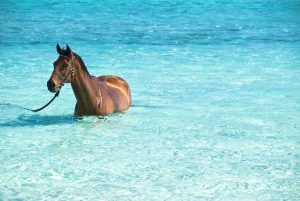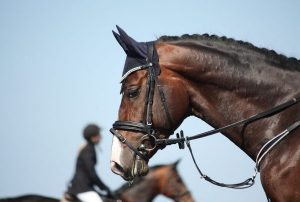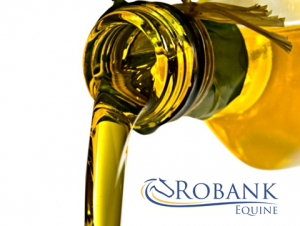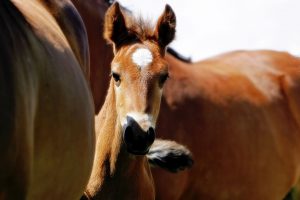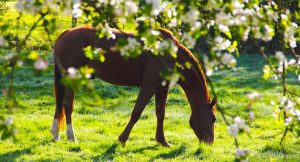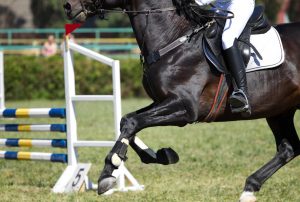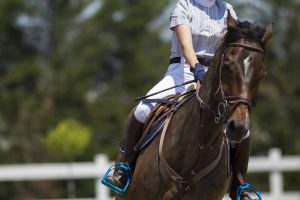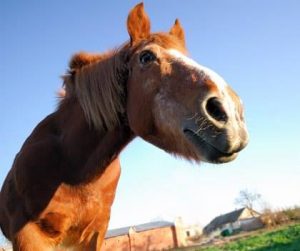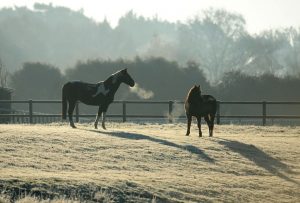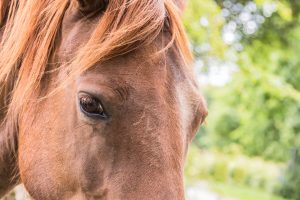
We have all heard the terms: “feeling their oats”, “high”, “fizzy”, “hot” and “hyper”. All terms used by horse owners to describe the effect that grain or certain feeds seem to have on the behavior of their horses. Does feeding management or individual feed ingredients really influence the behavior of horses? Sound scientific research on the effects of feed or feeding on horse behavior is scarce. However, a basic understanding of feed and feeding management coupled with data from other animals may help us determine if a “calming feed” actually exists or if it is just wishful thinking.
Feeding Management – The “natural” diet for a horse is often far different compared to the “performance” diet for a horse. The “natural” diet for a horse is one in which the horse has free-access to pasture. This allows the horse to graze nearly continuously. Given this opportunity, the horse will graze for approximately 16 – 18 hours per day. This facilitates a slow, continuous intake of fibrous feed into the digestive system. Another feature of the “natural” diet is the ability for horses to roam around the paddock. This provides the horse with an ample amount of natural exercise. Contrast the “natural” diet with the “performance” diet for a horse. The “performance” diet is typically feed two times per day to horses that are confined to a stall. These horses often finish their meals in a short time and then stand for long periods of time waiting for the next meal. The meals often consist of high-energy grain and limited amounts of hay or chaff. Further, since these horses are stalled or confined they do not have the opportunity for natural exercise.
So what effect does the “performance” diet have on the behavior of a horse? The main features of the “performance” diet are a low fiber intake, a small amount of time spent eating, a high grain intake and limited natural exercise. The combined result is an increase in stereotypic behaviors such as cribbing, wood chewing, weaving and stall walking. Many of these horses also exhibit excitable behavior. Scientists have tried to determine the exact cause or causes of these behavior problems. Possible explanations include: frustration due to confinement, lack of socialization with other horses, acid accumulation in the digestive system as a result of a low fiber, high grain intake leading to pain, or simply a lack of exercise leading to pent up energy.
Some of the negative behavior effects of the “performance” diet can be alleviated by modifying feeding management. First, provide horses with an adequate amount of forage. Horses require a minimum of 1.5% of their body weight in hay or pasture. For a 500 kg horse this equates to a minimum of 7.5 kg of forage. Horses will comfortably consume 2% of their body weight in dry forage (10 kg of forage for a 500 kg horse). Contrary to popular belief, providing adequate amounts of forage will not cause horses to become fat. Another management tool is to feed smaller meals on a more frequent basis. Feeding three or even four times per day keeps horses occupied alleviating boredom and frustration. It also slows the movement of material through the digestive system keeping the horses full and satisfied. Finally, giving horses an opportunity for turnout in a paddock or an arena will provide exercise and allow horses to expend pent up energy. Turnout for as little as 30 minutes twice a day will help keep horses mentally healthy and avoid negative stereotypic behavior.
Dietary Ingredients – Several ingredients fed to horses have been identified by horse owners as “heating” or having the potential to result in negative behavior in horses. The list of ingredients thought to cause problems include: oats, corn, barley, alfalfa (Lucerne) and molasses. Each of these ingredients is “thought” to make horses mentally hot or hyper and make horses difficult to handle or train.
Several possible explanations exist for why these ingredients may alter behavior in horses. First, each of these ingredients contains a significant amount of calories. Negative behavior may simply be a result of overfeeding calories to horses that are not adequately exercised. Since an overfed horse would have plenty of energy, and they are not getting adequate turnout or forced exercise, they may channel the energy into negative behavior.
Another, more scientific explanation for the change in behavior may have to do with the sugar and starch content of the diet. Sugar and starch are found in large quantities in cereal grain. When grain is digested in the small intestine of the horse the end product is glucose which is absorbed into the blood. Fluctuation in blood sugar may be the cause of behavior changes. Research has demonstrated that horses fed the exact same number of calories as either starch or fat had more spontaneous activity and reactivity to stimuli when fed a starch-rich diet compared to a fat supplemented diet. So is fat a non-heating ingredient, or is it simply the fact that less sugar was fed to the fat-supplemented horses? Simply stated, more research is needed to answer this question. This brings up another interesting question. If changes in blood sugar cause behavior changes then why don’t all horses have behavior changes when fed grain? The answer may lie in the fact that horses have large differences in their ability to digest starch, and thus alter blood sugar.
Another interesting theory for the reason certain feeds may cause behavior changes revolves around the brain neurotransmitter – serotonin. It is important to understand that this theory has not been tested or studied in detail in horses. For humans, serotonin functions to regulate mood. Low levels of serotonin are often associated with depression. Thus, many human depression medications function to increase the level of serotonin in an effort to improve mood. In the human body, high levels of glucose from the digestion of starch increase serotonin levels. This improves mood, making humans more alert and active. So if we attempt to apply this theory to horses, realizing this has not been thoroughly studied in horses, we may paint a picture that high starch (grain) diets result in high levels of serotonin and the horse feels good and becomes more active. A horse that feels good may be thought of by many horse owners as one that is “hyper”, “hot” or “fizzy”.
What about the protein in the diet making horses “hot”? Excess protein fed to horses can be metabolized and utilized for energy. However, protein itself does not seem to influence behavior. The individual effects of amino acids, the building blocks of protein, have not been studied to determine their effect on mood or behavior.
Finally, many horse owners do not feel that feed influences behavior. These horse owners simply feel that a well-fed horse is displaying its’ normal or true behavior. If you want to change or modify this behavior the horse simply needs to be trained so the energy is channeled into positive work rather than poor behavior. In reality feed likely has the potential to modify behavior, but there are several ways horse owners can minimize any potential effect of feed. For example, instead of feeding a diet that relies heavily on corn, oats and molasses the diet can be modified
to replace some of the grain with beet pulp, a low sugar, high fiber ingredient. Molasses in feed can be partially replaced with vegetable oil, an ingredient that does not contain any sugar. Feeding the grain concentrate portion of the diet in three meals per day instead of two meals per day also helps minimize large fluctuations in blood sugar. Finally, feeding a larger volume of good quality hay or pasture provides additional calories and helps minimize the amount of grain that must be fed to maintain body weight.
Calming Feeds or Supplements – There are several horse feeds and supplements on the market that claim to be “calming” or “non-heating”. Horse owners are happy to purchase these products because of the potential benefit. Most horse feeds that claim to be “calming” or “non-heating” include low sugar ingredients such as beet pulp. In addition, they are supplemented with fat to provide non-sugar calories for the horse. Overall, these feeds generally contain lower sugar content, thus potentially resulting in less negative behavior if fed correctly.
Supplements that claim to calm horses typically have several common ingredients including thiamin and magnesium. A deficiency of either the B-vitamin thiamin or the mineral magnesium results in nervousness, anxiety and even convulsions. Typical diets fed to horses are rarely deficient in either thiamin or magnesium. Adequate research has not been conducted to validate the effectiveness of these supplements; however, over-supplementation of the diet with these two ingredients does not result in toxicity issues. Several herbal ingredients are utilized to calm horses; unfortunately, many of these substances are banned substances that cannot be utilized in the diets for competition horses. Care must be used in administering any of these products to horses.
Summary – Both feeding management and individual feed ingredients have the potential to produce negative behavior in horses. Confinement in stalls in combination with being fed two meals per day is a potential cause of digestive irritation and negative behavior. Modification of feeding management to mimic grazing situations in which horses have constant access to hay (a minimum of 1.5% of body weight in dry hay per day) and reducing the size and increasing the frequency of feedings helps horses alleviate boredom and anxiety. Turnout in a paddock or an arena provides natural exercise for horses and it decreases stress and stereotypic behavior.
Feed ingredients such as oats, corn, barley, alfalfa and molasses have been identified by horse owners as causing “hyper”, “fizzy” or “hot” horses. Grains contain starch and sugar that may result in large fluctuations in blood sugar and result in mood or behavior changes. Modification of the diet to include less grain, more hay and low sugar ingredients such as beet pulp and fat have shown to decrease activity and reactivity of horses to their environment.
Finally, supplements designed to calm horses typically include nutrients that when deficient in horse diets cause anxiety or excitement. Normal horse diets are rarely deficient in these nutrients, but supplementation is generally safe. The effectiveness of these products has not been adequately tested so they may not have a calming influence on the horse.
